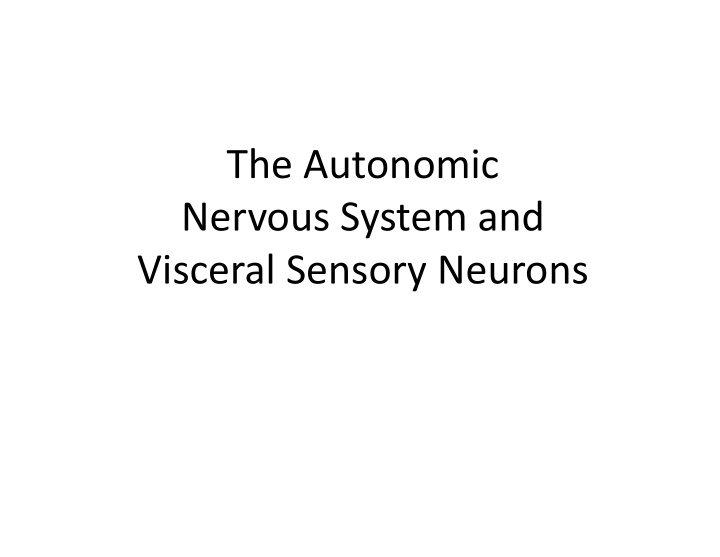



The Autonomic Nervous System and Visceral Sensory Neurons
The Autonomic Nervous System and Visceral Sensory Neurons • The ANS – a system of motor neurons – The general visceral motor division of the PNS – Innervates smooth muscle, cardiac muscle, and glands – Regulates visceral functions • Heart rate, blood pressure, digestion, urination . . .
The Autonomic Nervous System and Visceral Sensory Neurons
Comparison of Autonomic and Somatic Motor Systems • Somatic motor system – One motor neuron extends from the CNS to skeletal muscle – Axons are well myelinated, conduct impulses rapidly • Visceral Motor (Autonomic nervous) system – Chain of two motor neurons • Preganglionic neuron • Ganglionic neuron – Conduction is slower due to thinly or unmyelinated axons
Comparison of Autonomic and Somatic Motor System Pathways
Divisions of the Autonomic Nervous System • Sympathetic and parasympathetic divisions – Chains of two motor neurons • Exhibits dual innervation – Nerves of both divisions innervate mostly the same structures • Cause opposite effects • Sympathetic – “fight, flight, or fright” – Activated during exercise, excitement, and emergencies – Concerned with liberating energy resources • Parasympathetic – “rest and digest” – Concerned with conserving and storage of energy
Differences in ANS Divisions • From different regions of the CNS – Sympathetic – also called the thoracolumbar division – Parasympathetic – also called the craniosacral division
Differences in ANS Divisions • Length of postganglionic fibers – Sympathetic – long postganglionic fibers – Parasympathetic – short postganglionic fibers • Branching of axons – Sympathetic axons – highly branched • Influences many organs – Parasympathetic axons – few branches • Localized effect • Neurotransmitter released by postganglionic axons – Sympathetic – most release norepinephrine (adrenergic) – Parasympathetic – release acetylcholine
Sympathetic Pathway
Parasympathetic Pathway
The Parasympathetic Division • Cranial outflow – Comes from the brain – Innervates organs of the head, neck, thorax, and abdomen • Sacral outflow – Supplies remaining abdominal and pelvic organs
The Sympathetic Division • Basic organization – Issues from T 1 ‐ L 2 – Preganglionic fibers form the lateral gray horn – Supplies visceral organs and structures of superficial body regions – Contains more ganglia than the parasympathetic division • Sympathetic trunk ganglia • Prevertebral ganglia
The Role of the Adrenal Medulla in the Sympathetic Division • Major organ of the sympathetic nervous system • Constitutes largest sympathetic ganglia • Secretes great quantities of norepinephrine and adrenaline • Stimulated to secrete by preganglionic sympathetic fibers
Visceral Sensory Neurons • General visceral sensory neurons monitor: – Stretch, temperature, chemical changes, and irritation • Cell bodies are located in the dorsal root ganglia • Visceral pain – perceived to be somatic in origin – Referred pain
A Map of Referred Pain
Visceral Reflexes • Visceral sensory and autonomic neurons – Participate in visceral reflex arcs • Defecation reflex • Micturition reflex • Some are simple spinal reflexes • Others do not involve the CNS – Strictly peripheral reflexes
Visceral Reflex Arc
Special Senses • Senses that have specific concentration of receptors – Vision – Hearing/Equilibrium – Smell – Taste
Visual Pathway • Optic nerve • Optic chiasma • Optic radiations – Lateral geniculate body radiates to visual cortex – Pulvinar (lateral thalamic mass) radiates to visual association areas – Other radiations to various nuclei involved in visual reflexes
Vision • The Eye
Vision • Retinal Layers – Outer • Photoreceptors – Inner • bipolar, horizontal and amacrine cells – Ganglion layer • Ganglion cells – Optic fiber layer • Forms the optic nerve
The Ear – Hearing & Equilibrium 1. Sound waves enter 4 2. Sound waves 2 3 modified 3. Sound waves 1 parsed & transduced 4. Action potentials sent
The Ear – Cochlea Detail 1. scala vestibuli 2. scala media 8 (chochlear duct) 3. scala tympani 1 4. hair cells 5. tectorial membrane 2 6. cochlear nerve 5 fibers 7. basilar membrane 4 6 8. spiral lamina 7 (osseous) 3
Basilar Membrane Resonance Frequencies
The Ear – Vestibule & Semicircular Canals
Relationship between bony and membranous labyrinth in the inner ear
Olfaction
Taste
Taste
Recommend
More recommend